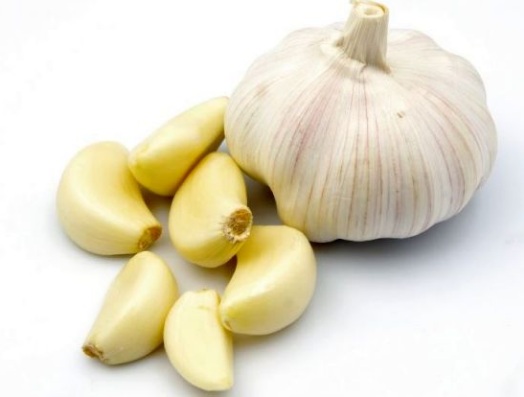Native to central Asia, garlic is one of the oldest cultivated plants in the world and has been grown for over 5000 years. Ancient Egyptians seem to have been the first to cultivate this plant that played an important role in their culture.
Garlic was not only bestowed with sacred qualities and placed in the tomb of Pharaohs, but it was given to the slaves that built the Pyramids to enhance their endurance and strength. This strength-enhancing quality was also honoured by the ancient Greeks and Romans, civilizations whose athletes ate garlic before sporting events and whose soldiers consumed it before going off to war.
Garlic was introduced into various regions throughout the globe by migrating cultural tribes and explorers. By the 6th century BC, garlic was known in both China and India, the latter country using it for therapeutic purposes.
Throughout the millennia, garlic has been a beloved plant in many cultures for both its culinary and medicinal properties. Over the last few years, it has gained unprecedented popularity since researchers have been scientifically validating its numerous health benefits.
Currently, China, South Korea, India, Spain and the United States are among the top commercial producers of garlic.
Garlic may help improve your iron metabolism. That’s because the diallyl sulphides in garlic can help increase production of a protein called ferroportin. (Ferroportin is a protein that runs across the cell membrane, and it forms a passageway that allows stored iron to leave the cells and become available where it is needed.)
The cardio protective benefits of garlic may partly rest on the production of hydrogen sulfide (H2S) gas. Our red blood cells can take some types of sulphur-containing molecules in garlic (called poly sulfide) and use them to produce H2S. This H2S in turn can help our blood vessels expand and keep our blood pressure in check. Interestingly, some processed garlic extracts cannot be used by our red blood cells in the same way and do not seem to provide the same level of cardio protection that is provided by garlic in food form.
With their unique combination of flavonoids and sulphur-containing nutrients, allium vegetables such as garlic belong in your diet on a regular basis. There’s research evidence for including at least one serving of an allium vegetable such as garlic in your meal plan every day. If you’re choosing garlic as your allium family vegetable, try to include at least 1/2 clove in your individual food portion. If you’re preparing a recipe, we recommend at least 1-2 cloves.
Garlic is a wonderful seasoning to add aroma, taste, and added nutrition to your dishes. We often recommend using raw chopped or pressed garlic in many of our dishes to take advantage of the benefits derived from garlic. However, if you cannot tolerate raw garlic, you can add chopped garlic to foods while they are cooking. It is best to add it towards the end of the cooking process to retain the maximum amount of flavour and nutrition
Health Benefits:-
The Blood Purifier
The Blood Purifier Tired of covering up those zits with concealer every morning? It’s time to tackle the root cause of acne by purifying your blood from inside to get healthy skin on the outside. Take two cloves of raw garlic with some warm water every day, early in the morning and consume a lot of water the entire day. If you’re looking to shed some pounds, squeeze the juice of half a lemon in a glass of luke warm water and have it with 2 cloves of garlic in the mornings. Garlic will help to cleanse your system and flush out toxins.
Cardiovascular Benefits
Most of the research on garlic and our cardiovascular system has been conducted on garlic powder, garlic oil, or aged garlic extracts rather than garlic in food form. But despite this research limitation, food studies on garlic show this allium vegetable to have important cardio protective properties. Garlic is clearly able to lower our blood triglycerides and total cholesterol, even though this reduction can be moderate (5-15%).
But cholesterol and triglyceride reduction are by no means garlic’s most compelling benefits when it comes to cardio protection. Those top-level benefits clearly come in the form of blood cell and blood vessel protection from inflammatory and oxidative stress. Damage to blood vessel linings by highly reactive oxygen molecules is a key factor for increasing our risk of cardiovascular problems,including heart attack and atherosclerosis. Oxidative damage also leads to unwanted inflammation, and it is this combination of unwanted inflammation and oxidative stress that puts our blood vessels at risk of unwanted plaque formation and clogging. Garlic unique set of sulphur-containing compounds helps protect us against both possibilities—oxidative stress and unwanted inflammation.
On the anti-inflammatory side of the equation, garlic’s 1,2-vinyldithiin (1,2-DT) and thiacremonone are the compounds that have been of special interest in recent research. Both compounds appear to work by inhibiting the activity of inflammatory messenger molecules. In the case of thiacremonone, it is the inflammatory transcription factor called NFkappaB that gets inhibited. In the case of 1,2-DT, the exact anti-inflammatory mechanisms are not yet clear, even though the release of inflammatory messaging molecules like interleukin 6 (IL-6) and interleukin 8 (IL-8) by macrophage cells has been shown to be reduced in white adipose tissue by 1,2-DT. The combination of anti-inflammatory and anti-oxidative stress compounds in garlic makes it a unique food for cardiovascular support, especially in terms of chronic degenerative cardiovascular conditions like atherosclerosis.
In addition to the ability of garlic to help prevent our blood vessels from becoming blocked, this allium vegetable may also be able to help prevent clots from forming inside of our blood vessels. This cardiovascular protection has been linked to one particular disulphide in garlic called ajoene. Ajoene has repeatedly been shown to have anti-clotting properties. It can help prevent certain cells in our blood (called platelets) from becoming too sticky, and by keeping this stickiness in check, it lowers the risk of our platelets clumping together and forming a clot.
Equally impressive about garlic is its ability to lower blood pressure. Researchers have known for about 10 years that the allicin made from alliin in garlic blocks the activity of angiotensin II. A small piece of protein (peptide), angiotensin II helps our blood vessels contract. (When they contract, our blood is forced to pass through a smaller space, and the pressure is increased.) By blocking the activity of angiotensin II, allicin form garlic is able to help prevent unwanted contraction of our blood vessels and unwanted increases in blood pressure.
More recently, however, researchers have found that garlic supports our blood pressure in a second and totally different way. Garlic is rich in sulphur-containing molecules called polysulfide. It turns out that these polysulphides, once inside our red blood cells (RBCs), can be further converted by our RBCs into a gas called hydrogen sulphide (H2S). H2S helps control our blood pressure by triggering dilation of our blood vessels. When the space inside our blood vessels expands, our blood pressure gets reduced. (H2S is described as a “gasotransmitter” and placed in the same category as nitric oxide (NO) as a messaging molecule that can help expand and relax our blood vessel walls.) Interestingly, our RBCs do not appear to use processed garlic extracts in the same way that they use polysulphides in food-form garlic.
Garlic’s numerous beneficial cardiovascular effects are due to not only its sulphur compounds, but also to its vitamin C, vitamin B6, selenium and manganese. Garlic is a very good source of vitamin C, the body’s primary antioxidant defender in all aqueous (water-soluble) areas, such as the bloodstream, where it protects LDL cholesterol from oxidation. Since it is the oxidized form of LDL cholesterol that initiates damage to blood vessel walls, reducing levels of oxidizing free radicals in the bloodstream can have a profound effect on preventing cardiovascular disease.
Garlic’s vitamin B6 helps prevent heart disease via another mechanism: lowering levels of homocysteine. An intermediate product of an important cellular biochemical process called the methylation cycle, homocysteine can directly damage blood vessel walls.
The selenium in garlic can become an important part of our body’s antioxidant system. A cofactor of glutathione peroxidase (one of the body’s most important internally produced antioxidant enzymes), selenium also works with vitamin E in a number of vital antioxidant systems
.
Garlic is rich not only in selenium, but also in another trace mineral, manganese, which also functions as a cofactor in a number of other important antioxidant defence enzymes, for example, superoxide dismutase. Studies have found that in adults deficient in manganese, the level of HDL (the “good form” of cholesterol) is decreased.
Anti-Inflammatory Benefits across Body Systems
Our cardiovascular system is not the only body system that may be able to benefit from garlic’s anti-inflammatory properties. There’s preliminary evidence (mostly from animal studies, and mostly based on garlic extracts rather than whole food garlic) that our musculoskeletal system and respiratory system can also benefit from anti-inflammatory compounds in garlic. Both the diallyl sulfide (DAS) and thiacremonone in garlic have been shown to have anti-arthritic properties. And in the case of allergic airway inflammation, aged garlic extract has been show to improve inflammatory conditions (once again in animal studies).
Even more preliminary is research evidence showing that some inflammatory aspects of obesity may be altered by sulfur-containing compounds in garlic. Specifically, there is one stage in development of the body’s fat cells (adipocytes) that appears to be closely related to status of our inflammatory system. Fat cells cannot become fully themselves unless they are able to progress from a preliminary stage called “preadipocytes” to a final stage called “adipocytes.” One of the sulfur compounds in garlic (1,2,-vinyldithiin, or 1,2-DT) appears able to lessen this conversion of preadipocytes into adipocytes, and the impact of 1,2-DT appears to be inflammation-related. Even though very preliminary, this research on 1,2-DT is exciting because obesity is increasingly being understood as a disease characterized by chronic, low level inflammation and our inflammatory status is precisely where garlic’s 1,2-DT has its apparent impact.
Antibacterial and Antiviral Benefits
From a medical history standpoint, the antibacterial and antiviral properties of garlic are perhaps its most legendary feature. This allium vegetable and its constituents have been studied not only for their benefits in controlling infection by bacteria and viruses, but also infection from other microbes including yeasts/fungi and worms. (One particular disulfide in garlic, called ajoene, has been successfully used to help prevent infections with the yeast Candida albicans.) Very recent research has shown the ability of crushed fresh garlic to help prevent infection by the bacterium Pseudomonas aeruginosa in burn patients. Also of special interest has been the ability of garlic to help in the treatment of bacterial infections that are difficult to treat due to the presence of bacteria that have become resistant to prescription antibiotics. However, most of the research on garlic as an antibiotic has involved fresh garlic extracts or powdered garlic products rather than fresh garlic in whole food form.
Overgrowth of the bacterium Helicobacter pylori in the stomach—a key risk factor for stomach ulcer—has been another key area of interest for researchers wanting to explore garlic’s antibacterial benefits. Results in this area, however, have been mixed and inconclusive. While garlic may not be able to alter the course of infection itself, there may still be health benefits from garlic in helping to regulate the body’s response to that infection. It is also beneficial in regrowth of hair naturally and helps in getting rid from baldness.
Cancer Prevention
While not as strong as the research evidence for cruciferous vegetables, research on the allium vegetables—including garlic—shows that these vegetables have important anti-cancer properties. Interestingly, high intake of garlic (roughly translated as daily intake of this food) has been found to lower risk of virtually all cancer types except cancer of the prostate and breast cancer. However, moderate intake of garlic (roughly translated as several times per week) has been repeatedly found to lower risk of only two cancer types—colorectal and renal cancer. This difference between “high” versus “moderate” garlic intake may be a real difference that suggests we all need to eat more garlic if we want to maximize its cancer-related benefits. Or it may be a difference that is more related to research complications involving the options given to research participants when reporting their food intake. Still, garlic has a consistent track record with respect to general anti-cancer benefits, and there are good research reasons for classifying garlic as an “anti-cancer” food. Some flowers are also helpful in preventing cancer.
The allyl sulfides found in garlic may play a key role in its cancer-prevention benefits. These garlic compounds are able to activate a molecule called nuclear erythroid factor (Nrf2) in the main compartment of cells. The Nrf2 molecule then moves from the main compartment of the cell into the cell nucleus, where it triggers a wide variety of metabolic activities. Under some circumstances, this set of events can prepare a cell for engagement in a strong survival response, and in particular, the kind of response that is needed under conditions of oxidative stress. Under other circumstances, this same set of events can prepare the cell to engage in programmed cell death (apoptosis). When a cell recognizes that it has become too compromised to continue functioning in a healthy manner with other cells, it stops proceeding through its own life cycle and essentially starts to dismantle itself and recycle its parts. It’s critical for a cell to determine whether it should continue on or shut itself down, because cells that continue on without the ability to properly function or communicate effectively with other cells are at risk of becoming cancerous. The ability of garlic’s allyl sulfides to activate Nrf2 suggests that garlic may be able to help modify these all-critical cell responses and prevent potentially cancerous cells from forming.
One especially interesting area of research on garlic and cancer prevention involves meat cooked at high temperatures. Heterocyclic amines (HCAs) are cancer-related substances that can form when meat comes into contact with a high-temperature cooking surface (400°F/204°C or higher). One such HCA is called PhIP (which stands for 2-amino-1-methyl-6-phenylimidazopyridine). PhIP is thought to be one reason for the increased incidence of breast cancer among women who eat large quantities of meat because it is rapidly transformed into DNA-damaging compounds
.
Diallyl sulfide (DAS), one of the many sulfur-containing compounds in garlic, has been shown to inhibit the transformation of PhIP into carcinogens. DAS blocks this transformation by decreasing the production of the liver enzymes (the Phase I enzymes CYP1A1, CYP1A2 and CYP1B1) that transform PhIP into activated DNA-damaging compounds. Of course, your best way to prevent formation of PhIP is not to bring your meat into contact with a 400°F/204°C cooking surface in the first place. But this area of research still bolsters our view of garlic as an allium vegetable with important cancer-preventive properties.
Garlic and Iron Metabolism
Recent research has shown that garlic may be able to improve our metabolism of iron. When iron is stored up in our cells, one of the key passageways for it to be moved out of the cell and returned into circulation involves a protein called ferroportin. Ferroportin is protein that runs across the cell membrane, and it provides a bridge for iron to cross over and leave the cell. Garlic may be able to increase our body’s production of ferroportin, and in this way, help keep iron in circulation as it is needed.
There is something irresistible about the aroma of roasted garlic. It is so captivating with its powerful notes, that it has long been used as a flavour booster in curries, stir-fries, pizza toppings, pastas, meat preparations, dips – you name it! It has the power to instantly liven up any dish and treat some of the most common ailments. Read on to unravel some surprising garlic benefits.
Raw Garlic Could Help Cure Lung Infection
While garlic is a common ingredient in every kitchen, in the ancient times, it was highly valued for its numerous health benefiting properties, which are still followed in many cultures today. Our ancestors have used it as a bug-repellant, Medieval Europe against plague and the Egyptians would even bury it along with their dead!
Garlic is going to provide you relief from that stubborn cold and flu (yes, they absolutely love you and never want to leave). Taking 2-3 cloves of raw or cooked garlic a day or sipping some garlic tea (with a touch of honey or ginger to lift up the taste) is not only going to relieve a stuffed nose and cure the cold but also build your immunity against these frequent visitors over time.
Allicin enters the body from the digestive tract and travels all over the body, where it exerts its potent biological effects (which we’ll get to in a bit).
Garlic Is Highly Nutritious, But Has Very Few Calories.
A1 ounce (28 grams) serving of garlic contains:
Manganese: 23% of the RDA.
Vitamin B6: 17% of the RDA.
Vitamin C: 15% of the RDA.
Selenium: 6% of the RDA.
Fiber: 1 gram.
Decent amounts of calcium, copper, potassium, phosphorus, iron and vitamin B1.
Garlic also contains trace amounts of various other nutrients. In fact, it contains a little bit of almost everything we need.
Cardiovascular diseases like heart attacks and strokes are the world’s biggest killers.High blood pressure, or hypertension, is one of the most important drivers of these diseases.
Human studies have found garlic supplementation to have a significant impact on reducing blood pressure in people with high blood pressure.
In one study, aged garlic extract at doses of 600-1,500 mg was just as effective as the drug Atenolol at reducing blood pressure over a 24 week period.
Supplement doses must be fairly high to have these desired effects. The amount of allicin needed is equivalent to about four cloves of garlic per day.
Kindly like us , share us and comment.



















Thanks a lot for sharing such a useful information,I just love each health and wellness blog !
See more benefits of garlic